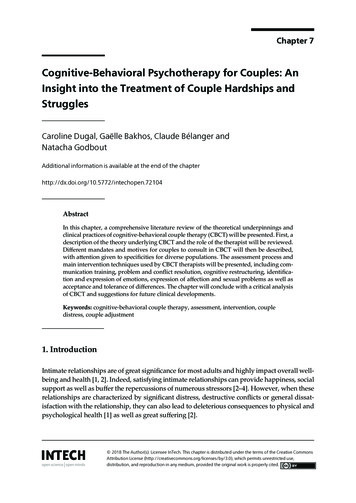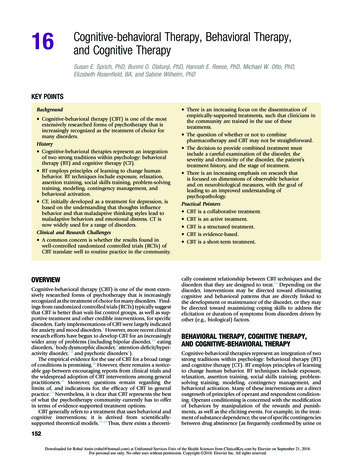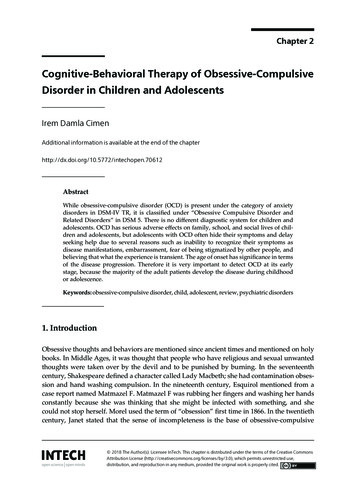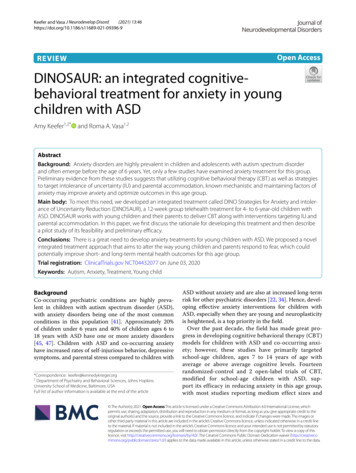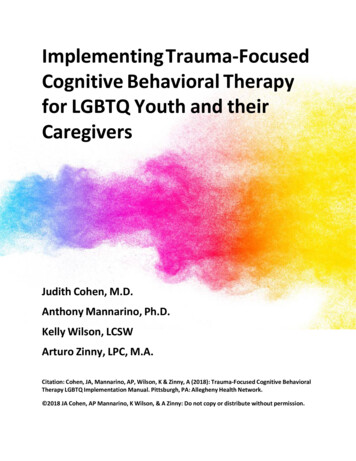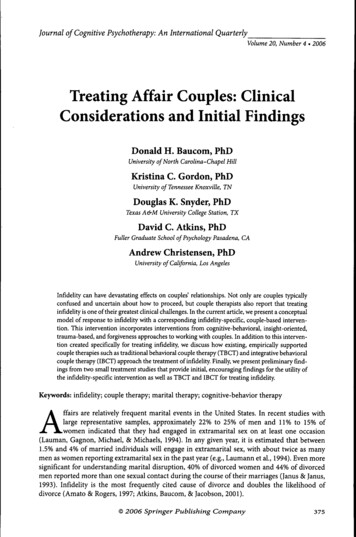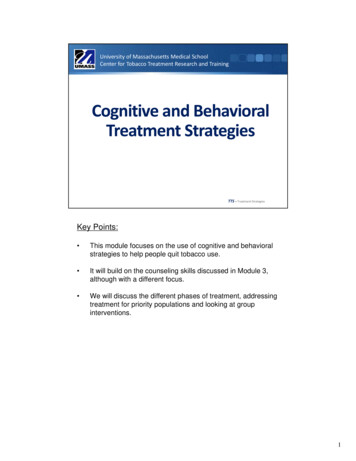
Transcription
University of Massachusetts Medical SchoolCenter for Tobacco Treatment Research and TrainingCognitive and BehavioralTreatment StrategiesTTS – Treatment StrategiesKey Points: This module focuses on the use of cognitive and behavioralstrategies to help people quit tobacco use. It will build on the counseling skills discussed in Module 3,although with a different focus. We will discuss the different phases of treatment, addressingtreatment for priority populations and looking at groupinterventions.1
Objectives1. Describe the differences between cognitiveand behavioral strategies2. List specific cognitive and behavioralstrategies for the pre‐cessation, cessation, andrelapse prevention phases of treatment3. Describe processes to promote relapserecovery4. Review treatment considerations for prioritypopulationsTTS – Treatment StrategiesKey Points: Goal of module: to provide an overview of treatment strategiesappropriate throughout the quitting process. The participant will inform the discussion around what works, whatdoesn’t. Challenge for today: How to combine--and effectively use--MIstrategies and cognitive behavioral strategies. These strategies may need to be more directive, due to theirbehavioral nature, and strongly encouraged. Your skill as a counselor is critical, motivating and encouragingclients to participate in these strategies whose effectiveness hasbeen demonstrated in the the literature. Remember to document all strategies that your client employs. Thismay help with billing and will help when writing a case study.Activity: Review module objectives on the slide2
Remember:Thoughts, Emotions, and SmokingTriggers of Smoking InitiationSituation: WorkThought: “I am so stressed out”Behavior:SmokeEmotion:Sad / OverwhelmedWe may be unaware of automatic thoughts, but aware of the emotions that they create within us unawareof these thoughts, but are very familiar with the emotions that they create within usTTS – Treatment StrategiesNOTE – this slide was presented in Module 1 – so this isjust a review.Key Points: Thoughts and emotions influence behavior. How you think can influence how you feel and subsequently howyou behave and can turn into a negative ‘vicious cycle’. On the other hand, positive thinking and managing emotions caninfluence behavior positively. This cycle of thoughts, emotions and behaviors form thefoundation of cognitive-behavioral therapy (CBT) which is oftenused to help a person quit smoking once they have made acommitment to stop.3
Cognitive StrategiesFocus on how thoughts influence resultingbehaviorsThe associations formed while smokingcontinue after physical withdrawal ceasesIdentify and “interrupt” negative thoughtpatternsIntroduce new ways of thinking about asituationLearn new ways of coping with stress andurges to smokeTTS– Treatment StrategiesKey Points: Cognitive and behavioral associations formed while smokingmay persist long after physical withdrawal ceases. The use of cognitive and behavioral strategies to address theseassociations is critical to cessation. These strategies help by: increasing client’s confidence in ability to quit; exploring ambivalence about quitting; learning ways of coping with stress and urges to smoke. A client’s physical and social environment is also critical indetermining behavior and should be addressed. TTS role: Assist clients to use their thoughts about tobacco useand cessation as a coping skill for triggers, i.e., focusing onreasons for quitting and consequences of tobacco use.
Behavioral StrategiesIdentify actions that replace or interfere withtobacco useDescribe behaviors that are measurable andobservable by othersInclude changes in the environment ‐ Thingsyou can change Should you buy gas, milk, etc. where you used tobuy cigarettes? “If you hang out in a barber shop long enoughsooner or later you’ll wind up getting a haircut”TTS – Treatment StrategiesKey Points: It is the combination of cognitive and behavioral strategies thatare shown to be most effective. Behavioral strategies are the actions the client takes or does tochange their tobacco use patterns. Specific strategies include escape, distraction or delay.Additional Background:You will often hear your clients refer to this as the “habit” part of theirtobacco use. Many already have a sense that changing this is goingto be an important part of quitting. Specific strategies that we can helpour clients employ may be escaping difficult trigger moments or usingdistraction or delay at moments we have an urge or craving to usetobacco. Cravings to use tobacco are brief on average, if we can helpour clients to cope or manage with these strategies they can facethese moments down.
A Framework for IntensiveMulti‐component TreatmentQuitting tobacco consists of five phases:‐ Building Motivation‐ Pre‐Cessation (Getting ready)‐ Cessation (Quitting)‐ Relapse Prevention (Maintenance)‐ Relapse RecoveryEffective treatment planning addresses all 5!TTS – Treatment StrategiesKey Points: One way to conceptualize the quitting process is to break it into 5 phases: Buildingmotivation, Pre‐cessation, Cessation, Relapse Prevention, and Relapse Recovery. The Building Motivation phase includes those smokers who are not ready to make aquit attempt. The Pre‐cessation (or Preparation) phase begins to prepare the smoker for quitting bystrengthening motivation to quit and by helping the tobacco user learn about his uniquesmoking habit. Many clients overlook or shortchange this phase. The Cessation (or Quitting) phase teaches specific strategies for quitting smoking ‐‐Period just prior to and during quit attempt. The Relapse Prevention (or Maintenance) phase helps smokers understand thatmaintenance of nonsmoking is the ultimate goal, while teaching specific strategies forachieving long‐term maintenance of nonsmoking. Finally, in the Relapse Recovery phase the goal is to re‐engage clients in treatment ifthey return to smoking after a quit attempt.Additional Background:Note that there is overlap between the phases and that quitting does not happen in thelinear way it appears on paper. However, it does make it easier to develop a quit planfor a smoker if you think about in these stages.6
Stages of ChangeTTS – Treatment StrategiesBuilding Motivation is appropriate for those in the Precontemplation andContemplation stages of change – that is for those not yet ready to commit to a quitattempt. It was the focus of the module on Motivational Interviewing.Today will focus on working with clients who are ready to commit to a quit attempt– those in the Preparation, Action and Maintenance stagesFinally we will discuss potential processes for those who have relapsed.7
Shared Decision Making:a key component of patient‐centered careClinician & client work together to make treatmentdecisions based on evidence that balances risks andexpected outcomes with client’s preferences andvaluesThe client:learns about & understands their health conditionsrecognizes a decision needs to be made & are informedabout different options (pros and cons)is better prepared to work with their providerThe provider:feels client’s gain knowledge & are better preparedfeels it helps client understand what we are trying to doSupports a needed lasting and trusting relationshipTTS – Treatment StrategiesKey Points: Website references include: www.healthit.gov/sites/default/files/nlc shared decision making fact sheet.pdf g/webinars/lcswebinar0504-slides.pdf8
ObjectiveDescribe the specific andappropriate strategies for thepre‐cessation phase of treatmentTTS – Treatment StrategiesKey Points: This section will describe strategies that can be used during thepre-cessation (or preparation) phase of treatment.9
Pre‐Cessation Phase – Key ObjectivesStrengthen and renew patient’smotivation to quit smoking or usingsmokeless tobaccoTarget quit date should be clearlyestablishedSelf‐monitoring of smoking/dippingbehavior should be encouragedLearn more about your triggersYou may have ones that you don’t realizeDevelop a plan of action!TTS – Treatment StrategiesKey Points: Motivation and Planning are the key objectives in this phase! There are several other important objectives during this phase:1. Set quit date2. Monitor tobacco use via pack wrap or journaling3. Develop a plan of actionAdditional Background:This slide (and the objective/strategy slides for the other 2 stages) ismeant to be more of a brief summary slide. Look for opportunities forfurther discussion during the small group reports after the exercise10
Pre‐Cessation Phase ‐ Treatment StrategiesCognitive Strategies: listing short & long‐term benefits of quitting (not only medical)Personalized health feedback: CO levels,pulmonary function, oral exams for ST usersSetting a target quit date provides time anddate to mobilize resourcesSelf‐monitoring of smoking/dipping behaviorPractice quit daysPharmacotherapyTTS – Treatment StrategiesKey Points: These are some of the intervention strategies that can be used inthe Pre-cessation (preparation) phase of treatment. Some preparation strategies (e.g., personalized feedback) arealso appropriate for smokers in precontemplation andcontemplation. Recent research shows some promise for using practice quitdays – either with or without medications. This may allow client tobuild self-efficacy and demonstrate how helpful medications andstrategies can be. Building in short-term reward – like using themoney saved for something else – may build motivation. If there has been a forced abstinence, e.g. during hospitalization,reviewing the use of pharmacotherapy during that time may behelpful.Additional Background: A reasonable quit date should NOT be in aday or 2 (usually need more time to prepare) but neither should it be too farin the future (such as a year off, too easy to procrastinate). A reasonablequit date will be 2-6 weeks in the future; it is often chosen to coincide witha special event, and it should not be scheduled during a particularly difficulttime. Also, for a woman, her menstrual cycle should be taken intoconsideration, as withdrawal symptoms are similar to PMS, and she will bedoubly uncomfortable. Wait until AFTER her period!The time is not set in stone: the date needs to work for the client. Helpfulfor a group to work towards the same quit day.11
Cognitive Strategies for Pre‐Cessation PhaseList benefits of quitting and harms of continuedtobacco use (short & long term)Post reasons in a visible placeInclude visual cues for reasons to quit (familyphotos, an activity you enjoy, etc.)List alternative thoughts to be used duringcraving“I can resist this one cigarette”“This craving will pass”“A cigarette won’t change this situation”TTS – Treatment StrategiesKey Points Help your clients explore how they currently think about tobacco use e.g. ”Ireally need a cigarette to relax” and find phrases to replace usual thoughts Keep the thoughts focused on positive and self-affirming languageActivity- Invite the group to brainstorm some positive phrases that clients may or havefound helpful.12
Self‐Monitoring of Smoking BehaviorKey Principle: To better change, a person mustfirst understand their own unique “relationship”with smoking or dipping.Increases knowledge about factors that cue andmaintain tobacco useSelf‐monitoring is reactive ‐ may result in areduction of smoking rate, however don’t makeconscious changes while self‐monitoringTTS – Treatment StrategiesKey Points: Keeping a written record of number of cigarettes smoked is a standardprocedure for any smoking cessation program, or any behavior changeprogram such as weight loss or exercise. Self-monitoring helps identify triggers and high risk situations. Self-monitoring helps a tobacco user to better understand his/herunique tobacco use patterns and therefore is critical in developingeffective coping strategies.Additional Background:Key principle – in order for clients to effectively change their smokinghabit, they must first gain an understanding of their own unique habitpattern Self-monitoring serves to increase knowledge about the factorscueing and maintaining one's smoking habit, Situational notations allowpatients to understand the environmental influences that trigger smoking13
How to do Self‐MonitoringGenerally called “Wrap Sheet” or “Pack Wrap”Self‐record each cigarette (or dip) before usingDate and Time of daySituation in which the cigarette was smoked Place Who withMood at the time of each cigaretteTTS – Treatment StrategiesKey Points: There are many names for this, usually called Pack Wraps orsome variation. Clients are to self-record each cigarette prior to smoking it, and torecord: Time of day Situation in which the cigarette was smoked (e.g., "withcoffee") Mood at the time of each cigarette (e.g., tense, relaxed,etc.) *Appropriate for chew and cigars as well, or even nicotine gum!Activity: Refer to Pack Wrap in handout sectionAdditional Background:A 2000 review of the literature on relapse and maintenance issuesby Judy Ockene et al found that higher use of self-monitoring wasrelated to both long and short term maintenance of nonsmoking.(Other cognitive factors included higher confidence and selfefficacy.)14
Pack Wrap ExampleTTS – Treatment Strategies15
Clinical VignettesTTS – Treatment StrategiesKey Points: These vignettes illustrate the issues that people addicted tonicotine face. They will be part of small group activities throughout the module.Activity: Vignettes are found in the Handout section of the manual.Assign one vignette to each table/small group. During brief breakout sessions, each table will develop astrategy for each phase of treatment for their specific vignette Ask a representative from each table to read the story labeled:Share with Everyone16
Small Group ActivityReview the vignette andadditional facts providedRecommend specific goals andstrategies for this clientTTS – Treatment StrategiesKey Point: To apply treatment ideas for each group’s specific client.Activity: Each small group brainstorms ideas ONLY for the pre-cessationphase of treatment for their client Each small group then reports back to the larger group, describingone strategy they would employ and why they would recommendthis strategy. Once all groups have reported, elicit additional ideas or suggeststrategies that may have been missed.Discussion points: What did you take into consideration when discussing apotential quit date? What is the purpose of self-monitoring? Why is it importantto keep a record? How might you present the benefits of self-monitoring to aclient?17
ObjectiveDescribe specific and appropriatestrategies for the cessation(quitting) phase of treatment – theperiod just prior to and during thequit attemptTTS – Treatment StrategiesKey Points: This section will describe strategies that can be used during thecessation (or quitting) phase of treatment. This phase can be thought of as the time around the actual quittingand there are a number of strategies that are appropriate at this stage. Somewhat arbitrary classification, but useful.18
Cessation Phase Treatment StrategiesCoping with triggersAltering smoking/tobacco use patternsIntegration of pharmacotherapyMaximizing social supportSelf‐help interventionsUrge coping strategiesTaperingTTS – Treatment StrategiesKey Points: These are the strategies recommended by treatmentexperts. We will take a few minutes to discuss each one. At the endof this section you will discuss how to apply strategies toyour client’s situation.19
Self‐Management – Coping with TriggersInvolves cognitive and behavioral strategiesthat rearrange environmental cues or triggersTrigger — situation, behavior, thought ormood commonly associated with smoking ordipping.Goal of self‐management:For patients to systematically practice using copingstrategies to not smoke or dip in identified triggersituationsTTS – Treatment StrategiesKey Points: The goal of self-management is for clients to systematically practiceusing coping strategies to not smoke or dip in their identified triggersituations. Self-management can be considered those strategies intended torearrange environmental cues that trigger smoking or that changethe consequences of smoking. A critical concept to quitting is that of the trigger --which is anysituation, behavior, thought or mood that is commonly associatedwith smoking a cigarette – sometimes referred to as “People, places,& things”. Remember to include other substance use.Activity: Ask: What are some common triggers? (Refer to triggerworksheet in members only section of website)Additional Background:Smoking is strengthened through its association with environmentalcues, as well as by the immediate positive consequences of smoking.Triggers represent classical conditioning! Phone rings, light a cigarette.Get in the car, light a cigarette. Finish a meal, light a cigarette. Getangry, light a cigarette!20
Self‐Management ProcessFirst step ‐ patients use information from self‐monitoring to develop list of triggersSecond step ‐ patients intervene to break upbehavior chain (situation urge smoke) usingone (or more) of 3 general strategies:Avoid the trigger situationAlter or change the trigger situationUse an alternative or substitute in place of thecigarette or smokeless tobaccoTTS – Treatment StrategiesKey Points: Review the behavioral chain of events which is repeated countless times inthe life of a smoker:Situation (trigger)---Urge---Smoke As smoking is a learned behavior, not smoking must also be learned. First step - patients use information from their wrap sheets to develop a listof their various trigger situations. Second step - patients begin to intervene actively in their naturalenvironment to break up the smoking behavior chain by utilizing one ofthree general strategies: avoid the trigger situation- Examples: skip coffee, avoid socialsituations w/ alcohol (at least temporarily), avoid former smoking"hang-outs", leave table after meals instead of lingering over coffee ordessert, don’t go to the convenience store etc. alter or change the trigger situation - Examples: Changing behavior- drink juice in morning instead of coffee, go for walk or jog instead ofwatch TV, pay for gas at the pump, not inside the station. Changingthoughts - Tell yourself "A cigarette won't change this difficult situation"or "I don't need a cigarette" rather than "I need a cigarette to cope”. use an alternative or substitute in place of the cigarette Examples: Alternate behavior - use of relaxation technique rather thana cigarette in stressful situation; use of gum, sugarless candy, fruit,plan health snacks as a reward rather than cigarette; call a friend, doneedlework or something to keep hands busy. "21
How might this be a triggering situation?What would you do?TTS – Treatment StrategiesAdded for a few laughs – at this point in the day and week you have to keep interestup!22
Altering Patterns of Tobacco Use May HelpAlter smoking patterns, rates & brand ofcigarettes or other tobaccoNo longer smoke in car, inside house, garageSwitch your cigarettes – brand, non‐menthol,etc.Only smoke alone (eliminate social factor)What are some that you can think of?TTS – Treatment Strategies23
Integration of PharmacotherapyCombination of CBT and pharmacotherapy ismore effective than either aloneCombination of pharmacological treatmentsadvised for heavy smokers and dipperse.g., patch (gum or lozenge), NRT bupropionMethod must be consistent with patient’spreferences & beliefsRemember: E‐Cigs/Vaping are often banned athospitals, planes, trains, etc .a good reason toconsider NRT use.TTS – Treatment StrategiesKey Points: Nicotine replacement, bupropion and varenicline have been shown to beeffective pharmacological smoking cessation treatments that can more thandouble quit rates. However, intensive psychosocial interventions in combination withpharmacotherapy significantly increase abstinence rates and have been shown tobe more effective than either alone. In selecting medications be sure to base the decision on consideration of thethree components covered in the module on pharmacotherapy: Agent, Patientand Medical factors. www.jointcommission.org/assets/1/23/jconline February 11 15.pdf https://youtu.be/NU1GKO-XlI8 rettes-inchecked-bags-on-planes.html www.amtrak.com/smoking-policy24
Maximizing Support for NonsmokingClinician support increases quit rates.Social support is also a key factor in smokingcessationSocial support from family, friends and co‐workersincreases quit ratesSocial support from romantic partners led to more quitattempts and more successful quits at 3 months.How can family and friends who smoke supportquitting?Consider on‐line social supportBuild on whatever social support you can!Burns RJ, et al, 2014TTS – Treatment StrategiesKey Points: Interventions which incorporate a supportive component by theclinician during the course of treatment (intra-treatment support)have been shown to increase quit rates. Support from the patient's environment has been associated withan increased likelihood of successful quitting. Ask even those whosmoke for ways they want to help support quitting The more support, the more likely to succeed. However,interventions designed to help patients' arrange to increase extratreatment support have not been particularly effective. We don’tknow how to help smokers engineer this.Nonetheless, it is important to help patients problem-solve howto deal with non-supportive individuals in their environment, aswell as how to minimize exposure to others' smoking in theirenvironment.25
Self‐Help InterventionsPrinted non‐tailored self‐help materials mayincrease quit rates but the effect is smallMany have moved to websites and appsMaterials tailored for specific individuals aremore effective than non‐tailored materialsInteractive and tailored internet programs weremore effective than written self‐help at sixmonths or longer.Look for evidenced‐based interventionsFiore M et al, 2008; Hartmann-Boyce J et al, 2014; Taylor et al, 2013;TTS – Treatment StrategiesKey Points: These recommendations are from a recent Cochrane Reviewabout the efficacy of self-help interventions. Self-help materials aren’t very effective by themselves. Tailored materials may be somewhat more effective.26
Urge Coping StrategiesEducate clients:Urges are time‐limited; not one continuous urgeUrges are stronger and more frequent upon initial quitting, butgradually diminish in intensityUrge coping strategies:Behavioral:4Ds: Delay, Drink water, Deep breathe, Distract (do something else) Drinking water gives you something to do with your hands Mindfulness apps help with deep breathingCognitive:“Urge‐surfing” ‐ imagery (urge peaks, then diminishes)“One day (hour, urge) at a timeTTS – Treatment StrategiesKey Points: Can’t always avoid trigger situation, so must teach urge-copingstrategies. Combination of behavioral and cognitive strategies may be usefulin dealing with urges to smoke. Psycho-education is important: Urges are time-limited; they willpass. They are stronger and more frequent upon initial quitting, butwill gradually diminish in intensity and frequency. Distraction can be an effective behavioral strategy – get busy anddo something to take one's mind off the urge. "Urge-surfing" – "go with the urge"; notice it, be a detachedobserver. Notice that it reaches a peak and then diminishes. Think about quitting "one day at a time" or even "one hour at atime". Thoughts about "quitting forever" can increase anxiety andintensify urges to smoke.Activity: Review the 4Ds:Delay, Drink water, Deep breathe, Do something else.27
Tapering/Gradual CessationRationale: Gradually reducing nicotine intake reduces intensity ofwithdrawal symptoms at quit date, so quitting may be less difficultReduce smoking by about 25% per weekST users: switch to brand with less nicotine (Copenhagen Skoal)Avoid unrealistically high goals (success builds self‐efficacy)Do not compensate by smoking harder/longer/deeperUse self‐management strategies to reduce cpdBelow 10 cpd or over 2 hours between smoking could introducewithdrawal½ life of nicotine is about 2 hours. Consider switch to NRTDon’t want to accidently reinforce smoking to relieve withdrawal!As effective as abrupt cessation (“cold‐turkey”) ‐ Hughes, 2008TTS – Treatment StrategiesKey Points: Clients work toward a target quit date by reducing number of cigarettessmoked by about 25% per week over 3 weeks as they work towards theirquit date.Clients should be cautioned about the possibility of compensation (smokinglonger, harder, deeper), and advised to keep such compensation changesto a minimum during the tapering process. When this happens CO testscores may remain high or even go up.Clients frequently report mild withdrawal symptoms .While these withdrawalsymptoms are more “spread out” over the course of quitting, they will beless intense at quit date.Clients may also switch to different, lower nicotine brands in order to disruptthe taste and pattern of smoking.Additional Background:If client’s regular brand is already at the lowest possible nicotine yield, they maychange to another brand of equal nicotine yield in order to disrupt the taste and"comfort" associated with smoking their regular brand. John Hughes (2008, Jr of Sub Abuse Tx) on gradual vs. abrupt quitting: Meta analyses, guidelines, Tx programs and regulatory agenciesvary widely in whether they include gradual quitting as an option More rigorous RCTs have found gradual as effective as abruptcessation NRT before quitting increases quit rates There is good rationale for gradual reduction of nicotine28
What about Hypnosis and Acupuncture?The efficacy of hypnosis and acupuncture hasnot been supported by empirical researchAcupuncture and related therapies (lasertherapy, electrical stimulation) – no consistentevidence that they are effectivehypnosis and/or acupuncture should not be utilizedas a primary form or major component of smokingcessation treatmentthey can be included as part of a comprehensiveprogramPHS Guideline, 2008; Barnes et al, 2010; White et al, 2014TTS – Treatment StrategiesKey Points: The efficacy of hypnosis has not been supported by empirical data.That is - there is no research to support that this is an effectivemethod of smoking cessation. Similarly, there is no empirical research to suggest that acupunctureis an effective method of quitting smoking. However, the latestCochrane review notes “ some techniques may be better than doingnothing, at least in the short term, and there is not enough evidence todismiss the possibility that they might have an effect greater than placebo.They are likely to be less effective than current evidence-basedinterventions.” Therefore, hypnosis and/or acupuncture should not be utilized as aprimary form of smoking cessation treatment. They can beconsidered adjunctive to behavioral therapy approaches withdemonstrated efficacy, but should never be the primary or majorcomponent of a tobacco treatment program.Additional Background:Any potential benefits of hypnosis may be as a means of helpingpatients to learn relaxation skills, although more established means ofteaching relaxation skills are discussed under Lifestyle Changestrategies.
Quitting Smokeless Tobacco:Special ConsiderationsBehavioral strategies are criticalOral health exam may increase/strengthenmotivation to quitReplacement products such as mint chew foundto be helpfulPHS Guideline reports insufficient evidence forpharmacotherapy recommendationsIt would not hurt ‐ harm reduction at least.Consider Mayo Clinic protocolTTS – Treatment StrategiesKey Points: Not as much to guide us when it come to helping people quitsmokeless tobacco. Herb Severson in Oregon and the Mayo Clinic in MN have done themost work in this area. They have found that one of the mosteffective strategies with smokeless tobacco users is having an oralhealth exam from their dentist. Some programs report that the use of mint snuff (non-nicotine) canbe helpful, as is switching to brands with lower nicotine contents ortapering schedule of use. Mayo Clinic treats their ST users with aggressive pharmacotherapy(refer back to slide in Pharmacotherapy section) What we know is that the same type of behavior modificationstrategies used for cigarettes is just as important with smokeless, ifnot more so.30
Quitting E‐cigarettes/Vaping: SpecialConsiderationsLittle evidence available for specific vaping strategies;currently being studied“Nobody is quite sure what to do with those wanting toquit, as this is all so new.”*Methods for quitting cigarettes may not readily applyto vapingAmount of nicotine inhaled/absorbed varies greatlyFormula for tapering may differSuggestion: use strategies that are evidence‐based fornicotine dependence* teenagers.htmlTTS – Treatment StrategiesKey Points: Little evidence is available for specific vaping strategies; currently being studied. What we know about nicotine dependence in youth has been based on cigaretteuse. How does Vaping technology and chemistry impact that? Try using CBT strategies can help with cravings, triggers, etc.: prepare byleaving your e-cigarette at home during the day, identify triggers, identifystrategies to use for cravings and triggers, ask for support from family andfriends.31
Quitting E‐cigarettes/Vaping: SpecialConsiderations for YouthSpecial considerations for youth: responsivenessof adolescent brain to nicotine; misperceptionsregarding nicotine content, dependence, andpossible risks; acceptability, culture of vapingThe US Food and Drug Administrationconsidering the role of drug therapies for youthdependenceThe Truth Initiative has expanded its quit‐smoking resou
One way to conceptualize the quitting process is to break it into 5 phases: Building motivation, Pre‐cessation, Cessation, Relapse Prevention, and RelapseRecovery. The BuildingMotivation phase includes those smokers who are not ready to make a quit attempt.


